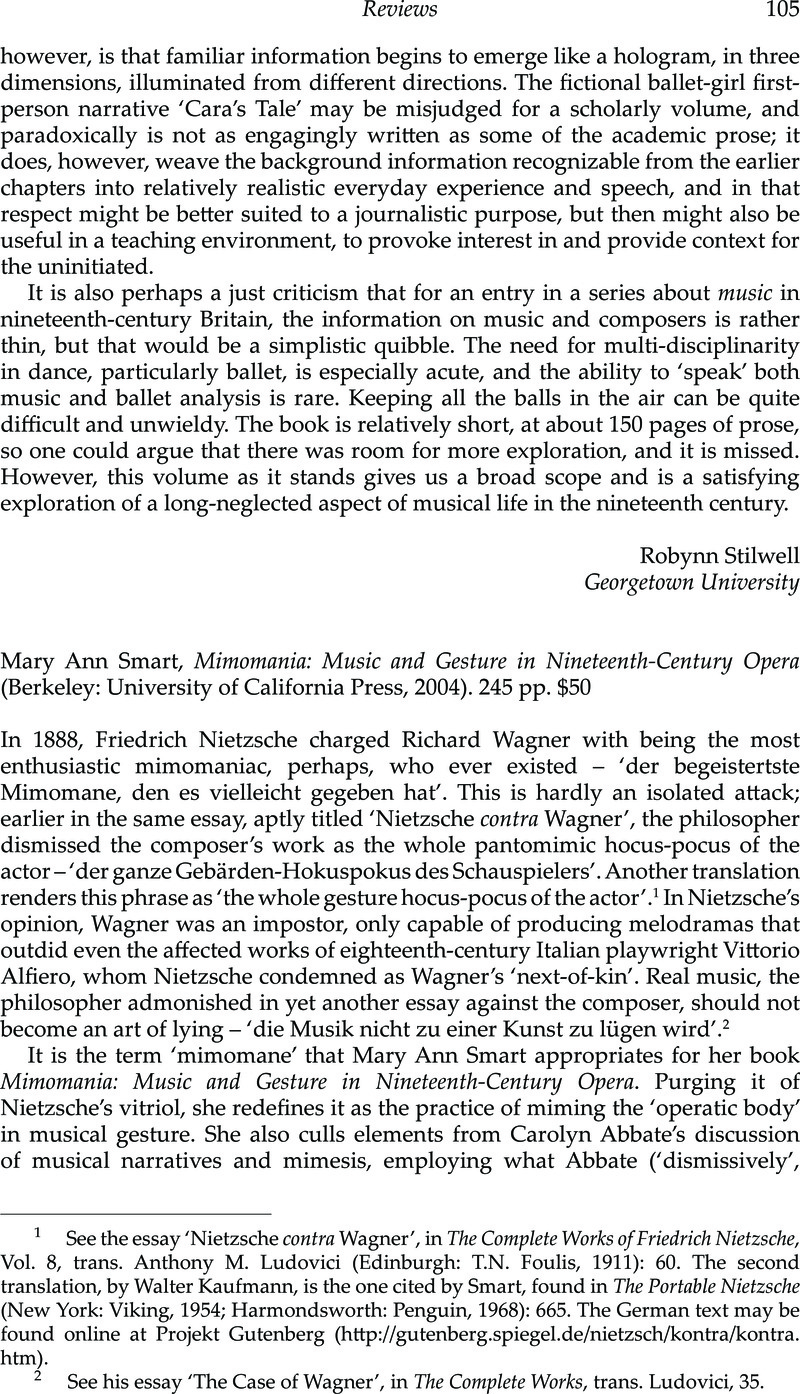No CrossRef data available.
Article contents
Mary Ann Smart, Mimomania: Music and Gesture in Nineteenth-Century Opera (Berkeley: University of California Press, 2004). 245 pp. $50
Published online by Cambridge University Press: 13 April 2011
Abstract

- Type
- Book Reviews
- Information
- Copyright
- Copyright © Cambridge University Press 2008
References
1 See the essay ‘Nietzsche contra Wagner’, in The Complete Works of Friedrich Nietzsche, Vol. 8, trans. Ludovici, Anthony M. (Edinburgh: T.N. Foulis, 1911): 60.Google Scholar The second translation, by Walter Kaufmann, is the one cited by Smart, found in The Portable Nietzsche (New York: Viking, 1954; Harmondsworth: Penguin, 1968): 665.Google Scholar The German text may be found online at Projekt Gutenberg (http://gutenberg.spiegel.de/nietzsch/kontra/kontra.htm).
2 See his essay ‘The Case of Wagner’, in The Complete Works, trans. Ludovici, , 35.Google Scholar
3 Abbate discusses musical narratives and what she calls ‘a miming model’ in the first chapter of her book Unsung Voices: Opera and Musical Narrative in the Nineteenth Century (Princeton, NJ: Princeton University Press, 1991).Google Scholar For Smart's comments on Abbate, see Mimomania, p. 11.
4 Her exploration of these examples from La traviata can be found on pp. 6–8.
5 Chief among Smart's feminist sources are Catherine Clémont, Susan McClary, Elin Diamond and Linda Nochlin. She also includes the germ of an interesting discussion on parallels between visible sound sources in film and opera, citing the research of Kaja Silverrnan.
6 In 1997, Smart read on La muette de Portici at the London meeting of the International Musicological Society; at the 1999 annual meeting of the American Musicological Society, she dealt with ‘gestural approaches’ to music in her paper on ‘Bellini's Self-Borrowings as Body Language’, a topic on which she later published in the Journal of the American Musicological Society 53/1 (2000): 25–68Google Scholar.
7 Parker, Roger, Leonora's Last Act (Princeton, NJ: Princeton University Press, 1997).Google Scholar
8 The former, on page 129, illustrates the chapter on Les Huguenots while the latter, on page 132, precedes the discussion of Verdi works. A propos of Smart's employment of the terms ‘mime’ and ‘gesture’, one dance scholar with whom I shared some points from this book was critical of Smart's synonymous use of the terms.
9 Gilbert's Chironomia, or a Treatise on Rhetorical Delivery, published in 1806, was an important source for the study of oration and gesture until the late nineteenth century. Rochas's Les Sentiments, la musique et le geste was published in 1900; although it dates nearly 20 years beyond the last opera in Smart's book, it includes information from earlier sources.
10 This rigid movement was one of the features of a 2005 production of La sonnambula, directed by Federico Tiezzi, in which the choreography of the chorus synchronized every gesture and step with the music.
11 Robinson, Paul, Opera & Ideas From Mozart to Strauss (New York: Harper and Row, 1985): 2.Google Scholar
12 Those who wish to trace just how Smart's scholarship has changed directions may compare (or better, contrast) her chapter ‘Bellini's Unseen Voices’ with the original chapter under that title in her PhD dissertation ‘’Dalla tomba uscita”: Representations of Madness in Nineteenth-Century Italian Opera’, Cornell University, 1994.
13 For a history of gestures that would still have been employed in the nineteenth century, see Robert McBride's ‘Ballet: A Neglected Key to Molière's Theater’, Dance Research: The Journal of the Society for Dance Research 2/1 (spring 1984): 3–18. Similarly, a history of gestures leading to the Cecchetti technique is found in Toby Bennett and Giannandrea Poesio, ‘Mime in the Cecchetti ’Method”’, Dance Research: The Journal of the Society for Dance Research 18/1 (summer 2000): 31–43.




